Table of Contents: February 2018 — Arts, Social Change, and a Vision for Sustainability [1]
Blatti JSE Feb 2018 Arts Issue PDF [2]
Introduction
To build a sustainable future, as a society, we must first imagine what it looks like. Art can be used as a means to inspire creativity in science, an essential skill in our future scientists, engineers, and citizens so that they are able to solve the challenges humanity faces. Art-science intersections are a powerful tool to evoke deep meaning in sustainability education. As science education is shifting towards more active learning, collaboration, and interdisciplinary research to reflect the manner in which science is conducted and to promote deep learning, there are opportunities to give students the freedom to think critically and solve problems, which plays a key role in their development as a scientist or engineer.
Although we see an emphasis to recruit students to STEM (science, technology, engineering, mathematics) careers early in their education, it does not always inspire creativity or encourage students to use their skills to build a sustainable future. This is particularly true in underrepresented populations, where students see a career in science or technology as a means to live a more comfortable life—which can be very resource intensive on our planet. Through our undergraduate research program at Pasadena City College (PCC), we translate our research in sustainable materials into outreach lessons to teach underrepresented middle school and high school students about sustainability.
We use Planetary Boundaries (PB) as a framework to discuss sustainability and develop hands-on classroom experiments to allow students to experience the scientific method. These engaging activities are rooted in creative inquiry and used to drive in-depth discussion, in which we relate environmental issues to students’ lives and lead them to discover that each individual contributes to our environmental impact. Our goal is to provide a meaningful, engaging learning experience early in science education to help students understand that every individual has an effect on our Planetary Boundaries.
At PCC, we have established an undergraduate research program designed to give students research experience at the onset of their careers to better inform their decision to pursue science, foster passion for science and research, and inspire creativity and critical thinking so that students are equipped to solve the imminent challenges of our time. Our research group has focused on fabricating sustainable paints, harnessing renewable energy (i.e. algae biofuels), DNA origami, and studying the environmental effects of plastics and nanotechnology. Sustainability and environmental awareness guide our research efforts, and we aim to have a broad impact by developing relevant curricula and outreach activities to teach underrepresented communities. We have implemented these activities at underrepresented middle schools and high schools throughout Los Angeles, such as in Compton, Boyle Heights, Hollywood, and downtown Los Angeles; we have also led workshops at many Girls Science Day events.
Planetary Boundaries in STEM Education Towards a Sustainable Future
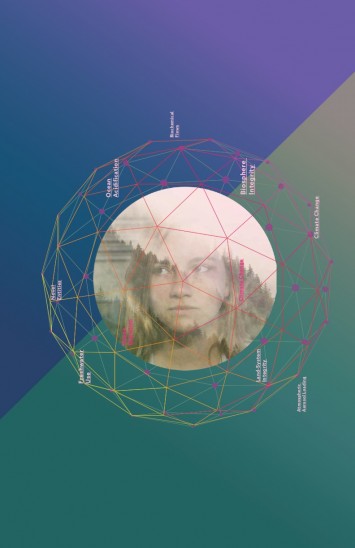 [3]
[3]Graphic design illustrating how planetary boundaries relate to an individual and his or her choices. This concept was used to teach underrepresented high school students about sustainability and to show them how a STEM education focused on sustainability can make a positive environmental impact.
During the Winter 2017, we were invited to be a part of the Sustainability Science and Engineering course at Caltech, and the course was brilliantly framed through the concept of Planetary Boundaries. Our community college students had the opportunity to interact with Caltech undergraduate and graduate students in meaningful discussions about various aspects of sustainability science and hear from the world’s leading experts on topics such as PB, climate change, water, biosphere integrity, geochemical cycles, and sustainable energy. As part of the class, we developed a project in which we used the concept of PB to teach underrepresented high school students about sustainability, how PB relates to each of their individual choices, and how they can use their STEM education to build a sustainable community and have a positive environmental impact. Importantly, this also leads to increased diversity in the STEM workforce.
We set out with the idea that individuals affect our Planetary Boundaries and education is the key to awareness and change. As students in underrepresented populations use STEM education to obtain careers in STEM and overcome poverty, they should be aware of their effects on our Planetary Boundaries. Our sustainability education project goal was to design engaging hands-on science education lesson focused on PB and use the lesson as a driving force to lead a discussion about sustainability and how each individual student can lessen their environmental impact, live more sustainably, and even obtain a job in the field of sustainability.
To represent our idea in a creative and artistic way, we created a graphic design that illustrates the use of the PB framework to relate each boundary to an individual’s choices. Notice how the individual student is at the center of the design to reflect this idea. PCC students introduced the concept of PB through engaging discussions and related it to each student’s goals and every day decisions. We guided the high school students as they synthesized algae biofuels, which they were very excited and inspired by. Students were very engaged when we connected sustainability to their lives and potential careers. One student at ALC said, “My favorite part of today was PCC people coming over and teaching us about sustainability and how it works. I learned that it can affect us in our everyday life, such as transportation.” Another student said, “I will try to pursue chemistry and make the world a better place”.
We have also continued to use a sustainable paints lesson as an engaging art-science intersection to teach underrepresented students about sustainability. Notably, this activity was carried out at a number of Girls Science Day and Girls STEAM (Science Technology Engineering Art Mathematics) events, and the girls commented on how much fun they were having doing science. In another Girls STEAM Academy outreach event at PCC, we used virtual reality (VR) as an engaging tool to visualize the Earth. The girls were very excited to use VR! This was followed by a lesson on sustainable agriculture in which students learned about different types of watering systems and were given the task to design a smart watering system to water the seeds they had planted. Our team then taught a short lesson on Python programming and Arduino technology and the girls split into teams and designed and built their devices. It was an incredible experience to watch the girls take pride in their design.
Teaching Underrepresented High School Students About Renewable Energy, Climate Change, and Algae Biodiesel, Using the Framework of Planetary Boundaries
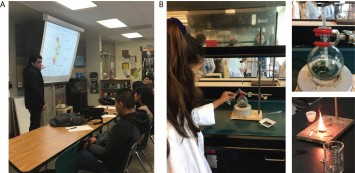 [4]
[4]A) PCC-led student discussion about Planetary Boundaries, renewable energy, climate change, and environmental issues related to urban Los Angeles; B) Student setting up algae biodiesel reaction and measuring its energy density.
Creative Chemistry: Making Simple Sustainable Paints From Natural Resources
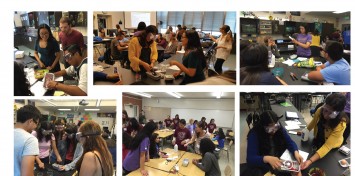 [5]
[5]PCC students taught middle school and high school students how to make sustainable paints from natural resources. Students are very engaged in this green chemistry activity, as they make a ‘green’ paint and use it to paint artwork describing the science of sustainability and what it means to them.
Virtual Reality in Sustainability Education
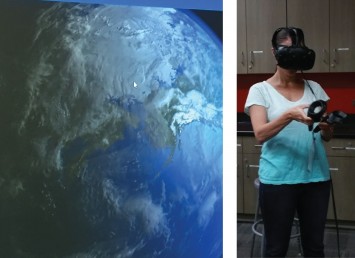 [6]
[6]Technology is a tool that can be used to inspire imagination and creativity, as well as visualize some of the Planetary Boundaries of Earth. Shown here is the use of virtual reality to visualize the Earth at the Girls STEAM Academy at PCC.
Middle School Students Designing a ‘Smart’ Watering System for Plants
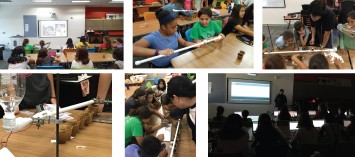 [7]
[7]PCC students led middle school girls through a discussion of agriculture and its environmental impacts.
Students were introduced to different types of watering systems and given the task to design and build a ‘smart’ watering The young girls successfully designed and built a smart plant watering apparatus, and they programmed water flow using Arduino technology. They tested their system, using it to water seeds they had planted.To inspire creativity in the science curriculum, we use many different art-science connections, including those that make use of nanotechnology, such as DNA origami—the nanoscale folding of DNA into 2D and 3D shapes—and nanoART—colorization of electron microscope images to emphasize features or highlight imaginative images. We have implemented a DNA origami lesson and scanning electron microscopy for nanoART, in outreach to underrepresented students, including girls and young women; students are always excited by these art-science intersections.
DNA Origami and NanoART Inspire Creativity in the Classroom
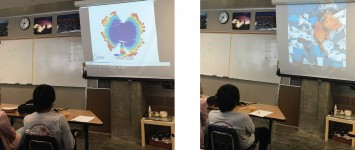 [8]
[8]Outreach to underrepresented high schools focused on DNA nanotechnology and electron microscopy. DNA origami and nanoART are art-science intersections that inspire creativity in science education. A program called caDNAno was used to design a DNA origami shamrock, which was folded and visualized using an Atomic Force Microscope. To teach students DNA origami in the classroom, various models and simulations were made. NanoART, or the colorization of electron micrographs, captures students’ imaginations and illustrates features in nanoscale objects.
Undergraduate Research and Sustainability Outreach Presentations
 [9]
[9]PCC students presented the results of their sustainability research and outreach efforts at the American Chemical Society National Meeting in San Francisco, the UCLA Undergraduate Research Conference, and at Caltech.
As part of the Art, Society, and Social Change issue of JSE, we believe that social change comes from awareness and education. Creativity in science can be inspired by art. Science and art have many intersections, which many people are beginning to appreciate. We also believe in social justice, and as such, our research and outreach program aims to bring awareness of sustainability and the challenges of our time to underrepresented populations. As we believe that nothing great can be accomplished without enthusiasm, we try to connect sustainability education to each student’s individual passions and show them how they can live more sustainably—helping their community, the world, and future generations. We have observed firsthand the impact of our efforts, as students recognize that they now have this awareness and become inspired and passionate about the environment. Our outreach program has already had a significant influence in the community. As even the high school students notice, small changes can lead to enormous impact; this is what it will take if we, as a society, are truly going to build a sustainable future.
Conclusion
Impact on high school students: Excerpts from communications with high school students and community college students about their experiences.
Surveys were carried out at the Academic Learning Center in Downtown, Los Angeles in an Environmental Science classroom. Pre and post surveys were conducted to see what the impact of the outreach lesson was on the students.
Before our lesson, students were asked:
- What is sustainability?
- Are you interested in sustainability and what ways do you practice it?
- How can you make your community more sustainable?
- Do you think you can get a good job in this area?
When asked what sustainability is, answers were mostly, “I honestly don’t know.” One student said, “something that doesn’t’ change for a while.”
When asked why they are interested in sustainability and what ways they practice it, they did not know how to answer. When asked how they can make their community more sustainable, one student said, “I need to know how to help my community first, then I can help.” Another said, “provide stable solutions so that problems stay solved for a while.”
When asked if students thought they could get a good job in this area, they did not know. One student said, “maybe, but I’d like to go someplace better.”
After the outreach lesson, the high school students made the following comments when asked about sustainability:
“My favorite part was learning about biofuel. I had no idea algae could be used to make fuel for cars. Instead of using our limited resources, we can use algae. It can replicate itself and rids the environment of carbon dioxide. Sustainability is, I guess, finding alternatives and using resources more efficiently. Using biofuels can be a big factor in influencing climate change.”
“What I liked about today was being able to see how a small change can affect our environment in a good way. It inspired us to be more involved in this area. Sustainability is when you take actions for the environment so that years later, the environment won’t be badly affected for our people.”
“My favorite part of today was seeing how soybean oil can be turned into biodiesel. It was fun to talk about observations as a group. Now, I think that sustainability is using resources to maintain and let organisms live and survive.”
“I really liked when we were doing the lab and observing all of the changes. Sustainability is basically when something stays constant and maintains.”
“My favorite part of today was putting the oil and water together. I got to see the two liquids separate. The separatory funnel is a cool device.”
“I will now try to pursue chemistry to make the world a better place.”
Impact on undergraduate students at PCC
Ellen: During the sustainability outreach lesson, students showed genuine interest in learning about sustainability and its applications. In fact, many were surprised that biofuel can be made from algae. There were a number of students who were not able to define sustainability on their surveys, indicating there is not enough emphasis on sustainability in schools. Focusing on sustainability education in the classroom can inspire greater involvement in sustainable living.
I have learned that showing students how sustainable practices are beneficial to humans is the best approach to influencing a more sustainable future. By discussing only the damages of living unsustainably, we can only have so much of an affect on the students before they likely revert back to their old ways. Sustainable habits are formed when people feel they are making contributions to society, rather than abstaining from destruction.
Introducing these ideas in combination with art is a wonderful way to capture attention of all audiences. This personifies sustainability and attracts creative minds, especially of a younger audience. There is a great need for citizen science in education to inspire the involvement of everyone in the community. Unity through collaborative efforts towards sustainability often results in powerful and lasting influence to drive progress further. Additionally, we must consistently practice mindfulness in acknowledging the effects of our resource usages. These lessons helped me emphasize sustainability in my own life. For example, I have changed the way I drive to be more fuel-efficient—conserving gas helps reduce usage while saving money. By showing that living more sustainably benefits both the environment and us, we are more willing to continue these sustainable habits.
I’ve come to the understanding that sustainability in education is key to making progress towards a more sustainable future. Our outreach lesson was shown to have a powerful impact on the students, helping me reinforce my career goal in pursuing science education, as well as evoking strong interests in sustainability research. Involving people of the community can be difficult, but if we can show that living more sustainably can be beneficial economically and to the environment, then we are headed in the right direction. It begins with education—planting the seeds with students through outreach and inspiring the same learners to go out into their communities and educate others about the benefits of sustainability. This is how we can build a sustainable future.
John: Education is always in the forefront of solutions to the world’s challenges, including building a sustainable way of living. I agree that education is important in solving most of our problems, but not the entire solution. Although education can make an individual aware, it often fails to present these issues in a more personal perspective to each individual. It is from the personal perspective that a person will be able to grasp value in his/her education and apply themselves to solve some of the challenges humanity faces. A rethinking in the way we educate is needed if we want to build a more sustainable world.
With the increasing demand and drive for STEM majors, people see this as a way to obtain a good career. There is an emphasis in schools towards a fact-based system, in hopes that both economic prosperity and ecological sustainability are both achieved. The knowledge gained from scientific studies is supposed to make individuals aware of the burden that society is placing on our planet, and at the same time, inspire them to find a way to lessen that burden. However, with mathematical and scientific facts more widely available than any point in human history, I see the opposite.
Every day, I see most of my fellow students studying hard—not to build a sustainable future, but ferociously paging through their textbooks for the big house, the two cars, and for better opportunities for their future children. They don’t see their education as a tool to make our world a better place, but as a (costly) investment to make their world a better place. It seems that the better off we are as a society, the more we want to consume. There is nothing wrong with trying to make a better future for oneself. It’s just that the way society as a whole envisions the role of education in people’s lives is counterproductive to building a more sustainable world. We, in turn, with our newly gained affluence, become bigger consumers. If science education by itself does not lead to a sustainable world, then what else is needed? We must first find what drives our endless and meaningless consumption.
We must also put science in focus to the average person. You can tell a person that global temperatures might rise by two degrees, but to most people, this problem seems small compared to when their next paycheck is coming in. If we can show how the big picture affects the individual’s world, then I believe that we can make progress to a better future for ourselves. It is through the combination of the sciences and philosophy that we can start/continue to answer those questions.
Every day we all engage in bit of philosophy. When we find ourselves in our room alone contemplating our life, actions, relationships, whether one really needs that shiny new thing; though superficially, we all are engaging in a form of philosophical thinking. But now we must start thinking deeper, so we can put in perspective all the parts of not just our own personal lives, but of others whom we inhabit the world with. While science provides us with the tools on how to live a sustainable life, philosophy and the humanities teach us the “why” and can help us focus the consequences on our daily lives. Both disciplines must work together, or we will keep shortchanging ourselves and our future generations. Just like it seems that nature always balances herself out to make livable habitats, so must we find a new balance in our education to make a more sustainable future.
Frieda: An important topic brought to my attention at the Caltech lecture was the significance of biodiversity in an ecosystem. This really stuck with me—specifically about how much the biodiversity of an ecosystem will suffer as a country develops. I was fascinated by what was said about Cuba, that despite the fact that they continued to develop (as much as they could), they had managed to maintain their biodiversity for the most part. It made me reflect a little more on the biodiversity in L.A. Living in South Pasadena, I don’t feel any real lack of nature. The city has a big focus on beautification, so there are plenty of green lawns and big trees. Ultimately though, there’s not very much variety. This lack of biodiversity seems to me like a quiet threat that could easily have much bigger implications than is currently realized.
Doing the outreach really helped to highlight to me that we (scientists) can’t just have our discussions in class and our experiments in lab. When it comes to sustainability and the environment, it really is going to come down to getting an entire world involved. Having the opportunity to bring this awareness to young children is priceless. I got the impression that the kids we spoke to care deeply about the future of our world. They have daily concerns that they have to take care of, and a future of their own to plan, but I think even the youngest child can understand what an important role they play in their own environment. When it comes to spreading this idea even more, I think it’s really important to understand the resources that most individuals are working with. In a rural community it would be easy to encourage everyone to start their own vegetable garden in the backyard they very likely have. In L.A., very few people have space for a vegetable garden. Biking to work instead of driving may mean over a hour journey on busy L.A. streets that aren’t always safe. I think that being ignorant of what people can feasibly do in their own life puts us at risk of being discounted when we try to offer solutions.
My favorite part of our research is the diversity of everyone in the group. I think we have great group energy, and everyone brings something unique to the group. We have different backgrounds and interests, and it all comes together in a way that I find very inspiring. Being able to experience this kind of teamwork towards common goals makes me optimistic and excited for my future in a STEM field. It’s a different experience from assigned group projects in class, in that there is such a level of passion and excitement about making real these ideas that we care so much about. The group’s focus on outreach also has helped to widen my perspective on the role of scientists. It’s about so much more than getting your research published; it’s about communicating. Or it should be anyways.
Naneh: Growing up, sustainability was not a concept I was very familiar with. It was only during my involvement with this research group that I was introduced to the idea in more detail than a mere mention of the word and realized the incredible importance of it. Despite having been unable to attend the Sustainability Science and Engineering Course at Caltech, I kept up with all received readings and participated in many of our groups’ discussions thereof, furthering my interest and knowledge in the subject. Knowing what I do now, I find it incredibly important to educate the younger demographic about sustainability and specifically, about planetary boundaries.
By bringing this information to students early, we can guarantee that future leaders are at least aware of the environmental impact of their actions and, hopefully, act conscientiously regarding the wellbeing of our planet. I have certainly noticed that I have begun to spend more time focusing on this concept with my tutees, beyond the single-sentence definition mentioned in their biology book, often drawing upon our groups discussions in my explanations. Had it not been for my participation in this research group, quite a few of my skills would likely have remained stagnant. Through this group, I was given the opportunity to widen my world-view and familiarize myself with more fields of knowledge.
I was also lucky enough to work in a highly cooperative and supportive atmosphere with incredible, intelligent colleagues, and learn skills and techniques vital to my future success. Thanks to our work, I rediscovered the beautiful and awe-inspiring nature of science, the very concepts that had drawn me to the field to begin with — concepts that had been stifled and repressed under the stress of the educational system. I am incredibly thankful to have had the opportunity to participate in this group and for all the benefits this participation has led to. I can truly say that this group has been the best part of my collegiate experience so far.
Felix: Prior to participating in the Sustainability Science and Engineering course at Caltech, my outlook in renewable energy and sustainability was that of: “It’s for them, not me. I don’t have the resources, social status, or time to invest in that. I need to become financially stable first.” Now, I have come to realize that that attitude is a scapegoat; not because it is a lazy perspective, but from and an honest point of view that stems from a certain lack of understanding. Learning about the numerous projects being carried out throughout the developed and underdeveloped world, I know that all it takes is motivated individuals to carry out change. Whether it is studying biological diversity in local forests or teaching the next generation about sustainability and science, I can make a difference.
When I participated in Pasadena City College’s undergraduate research experience program, I had the opportunity to not only research advanced scientific topics but share those topics as an educator to high school students. At first, it seemed as if these high schoolers were quite uninterested in the topics, Which I and my colleagues presented—since they were unfamiliar with the topic—but soon after we delved deeper into it and showcased the wonderful and practical aspects of the science, these students showed a visual turnaround to their initial attitudes. This not only overwhelmed me with joy but showed me that when you come to a topic with passion others will not only instinctively feel your passion but internalize and consider your passion as their own.
Danyal: Participating in the Sustainability Science and Engineering course at Caltech has affected me and my views about what is happening in the world, showing how something so small can have a huge impact on the environment. Key things that I have learned in this course that I can apply to my life is that it isn’t too late to try and fix things and to be able to tell my family and friends that the little things like recycling can help the planet. Our idea to bring planetary boundaries to students through education, using hands-on experiments instead of lecturing, helps students engage in learning about what is happening to the planet and how their impact can drastically alter the planet in a helpful way or damage it even further.
The research group has influenced me in a way that it made my love for science even more so, and that we are trying to make a difference in other people’s lives by showing and expressing our love for this planet and everything in it. Going out to teach students about the world amazes me because these students are being able to see what is going on and the impact they are making, something that many students don’t experience because their educational curriculum doesn’t focus on the planetary boundaries and teach students the difference they can make.
Jason: The outreach done at ALC was very interesting to me. The way the students’ views evolved as the lessons progressed was eye opening for me as I thought the subjects we were presenting were common knowledge. My views of sustainability didn’t change but my viewpoint on people’s understanding of planetary boundaries did. I believe that people need to understand the effects of living an unsustainable lifestyle. Having them know that their actions today would affect the world that is left behind for future generations.
The research group has taught me that Science is a collaborative effort and not everyone on the team needs to be an expert in every aspect of the subject being studied. It was interesting seeing how everyone had a role in bringing the project to fruition and I value the comradery that has developed between us. I have never seen a more enthusiastic group than the ones who attended the girls STEAM event. As the day progressed, I was left in awe as to how much they knew about current technology. For example, when asked whether they had previous experience with VR, many of them raised their hands. They were not hesitant to ask questions and the thirst for knowledge was palpable. It was great seeing them jump right in to assembling the watering mechanism and going through the scientific method when something did not work, for it is the trials and errors that fuel scientific progress!
Edward: As part of the group, advocating sustainability is very important to me. I find it crucial to teach other students the importance of finding a sustainable future. After all we only have one planet that we call home. Through sustainability, we want to effectively utilize the resources we have in order to maintain the current generation without stopping future generations from maintaining themselves. By being in this research group, I have really enjoyed discussing and creating ideas with people who share the same passions and interests as I do.
Teaching the younger students about sustainability through the outreach program was a new and influential experience for me. I found it as an effective method of giving them insight about how the many different fields of science can ultimately come together to contribute for a sustainable future as well as providing the knowledge and skills needed to make that goal a reality. Most students are always curious about how things work or new ideas – especially at a young age and we hope that through these sustainability lessons we can help spark (or amplify) their interests in such fields. Overall, my experience with sustainable education has greatly changed my perspective on how sustainability can be taught to students from different types of schools despite their economic status.
I attended a high school in east LA that did not have much money; albeit a magnet school and therefore a little more economically fortunate than others in the same area, it still had a relatively low budget – some of our technological equipment was dated and our chemistry stockroom was about the size of a small walk in closet. Taking this into account, my fellow group members and I find it essential that we can teach others in such ways that the lessons or demonstrations can be conveniently replicated inside the classroom for future generations. Such can be made possible by using inexpensive materials and equipment that even schools in lower socioeconomic districts can acquire. This idea mirrors how sustainability is taught in developing countries. This is our group’s ultimate goal.
Anjalee: The Girls STEAM outreach event was absolutely amazing! As the girls poured into the room, my nervousness started to grow but I felt amazed at how enthusiastic they were at the very beginning. Jiaqi did an awesome job with his presentation about VR, highlighting the planet Earth, and the girls were incredibly excited about the VR, even me!
Overall, the outreach was one of the most enjoyable teaching and learning experiences that I have ever encountered in my entire life. I felt really happy and accomplished! Passing our knowledge to a younger generation of motivated learners was something that, I decided, I really enjoyed doing. I also found out that I loved not just the biochemical aspects of science but that I also have a passion for agriculture, physics, engineering and technology! Learning is a fun, memorable, and enjoyable experience. Our workshop was proof of that!
Jiaqi: Science and art are more alike than different but there is often a miscommunication and misunderstanding between art and science. One problem that I notice, that is very detrimental to the promotion of interdisciplinary collaboration, is the lack of understanding of a discipline by others. Both artists and scientists often have misconstrued notions about each other before any contact is even made. The underlying presumptions and assumptions made (often subconsciously) seem like a key issue in causing difficulty in communication. Often both artists and scientists think of each other as polar opposites, whereas they are much more closely related than they may realize.
Acknowledgments
We would like to thank Profs. Mamadou Diallo and Julie Kornfield at Caltech for the invitation to be a part of the Sustainability Science and Engineering course in the Winter of 2017, which inspired the use of Planetary Boundaries as a framework to discuss sustainability and develop relevant activities and discussions in outreach efforts. We would also like to thank the teachers who allowed us to come into their classrooms at Compton High School, Academic Learning Center L.A., APEX Academy in Hollywood, Mount San Antonio College, and Pasadena City College, and the amazing students.
References
Ballen, C., Wieman, C., Salehi, S., Searle, J., and Zamudio, K. (2017). Enhancing diversity in undergraduate science: Self-efficacy drives performance gains with active learning. CBE Life Science Education. 16(4): ar56, 1- 6.
Blatti, J., Cuccinello, A., Juarez, B., Liang, W., Lu, J., Massine, N., Portillo, J., Pourmand, E., Ramirez, A., Sanchez, V., and Sepulveda-Torres, C. (2016). The City of Roses—Pasadena City College and the chemistry research laboratories. J. Sust. Ed., 11(Place and Resilience in Sustainability Education), ISSN: 2152 – 7452.
Blatti, J. (2017). Colorful and creative chemistry: Making simple, sustainable paints from natural pigments and binders. J. Chem. Educ., 94(2), 211-215.
Blatti, J. and Burkart, M. (2012). Releasing stored solar energy within pond scum: Biodiesel from algal lipids. J. Chem. Educ., 89(2), 239-242.
Brand, S. (1988). Inventing the Future at MIT. Penguin Books: Berkeley, CA.
Claroa, S., Pauneskub, D., Dweckb, C. (2016). Growth mindset tempers the effects of poverty on academic achievement. Proc. Natl. Acad. Sci., 113(31), 8664-8668.
Dewey, J. (1934). Art as Experience. Milton, Balch, and Company: New York, NY.
Dewey, J. (1938). Experience and Education. Collier Books: New York, NY.
Edwards, D. (2009). ArtScience: Creativity in the post-Google generation. Harvard University Press, Camberidge, MA.
Freeman, S., Eddy, S., McDonough, M., Smith, M., Okoroafor, N., Jordt, H., Wenderoth, M. (2014). Active learning increases student performance in science, engineering, and mathematics. Proc. Natl. Acad. Sci., 111(23), 8410−8415.
Gurnon, D., Voss-Andreae, J., Stanley, J. (2013). Integrating art and science in undergraduate education. PLoS Biol., 11(2), e1001491.
Robinson, C. (2012). The role of images and art in nanotechnology. Leonardo, 45(5), 455-460.
Root-Bernstein R., Siler, T., Brown, A., Snelson, K. (2011). ArtScience: Integrative collaboration to create a sustainable future. Leonardo, 44(3), 192.
Steffen, W., Richardson, K., Rockström, J., Cornell, S., Fetzer, I., Bennet, E., Biggs, R., Carpenter, S., DeVries, W., DeWit, C., Folke, C, Gerten, D., Heinke, J., Mace, G., Persson, L., Ramanathan, V., Reyers, B., and Sörlin, S. (13 February 2015). Planetary boundaries: Guiding human development on a changing planet. Science, 347(6223). DOI: 10.1126/science.1259855.